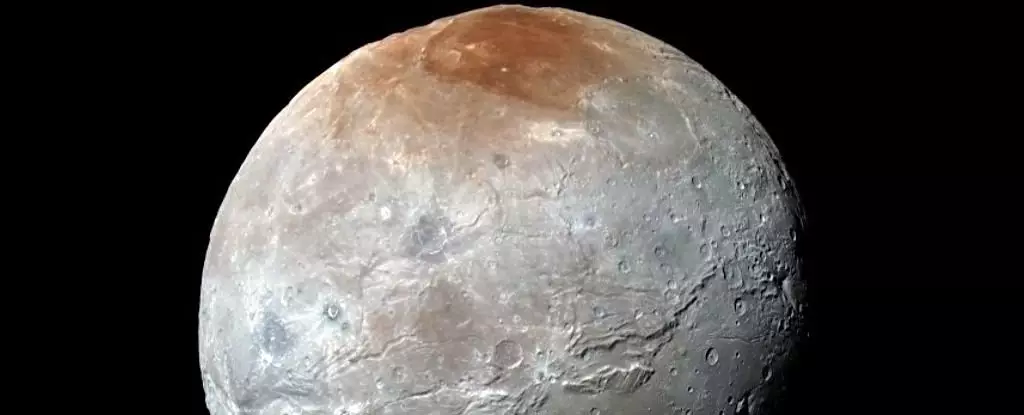At the fringes of our Solar System, approximately 5.7 billion kilometers from the Sun, lies Pluto, the dwarf planet that has fascinated astronomers and enthusiasts alike. Despite its diminutive size—smaller than Australia—Pluto is a complex world of icy terrains and geological features, enveloped in a frigid environment that averages a staggering -232°C. Accompanying Pluto are five moons, with Charon being the most notable for its exceptional size and intriguing characteristics. Together, they create a unique system that defies conventional planetary classifications, generating endless curiosity and scholarly inquiry.
Charon, measuring over 1,200 kilometers in width, is notably the largest moon in proportion to its parent body in the Solar System, at nearly half Pluto’s size. This distinctive relationship fosters a “binary system” dynamic, wherein both Pluto and Charon orbit around a common barycenter, drawing a stark contrast to the Earth-Moon system. Here, the Moon orbits Earth, while Earth remains relatively stationary in comparison. This duality contributes to the criteria that led to Pluto’s reclassification from planet to dwarf planet; it has not cleared its orbit, which is a requisite for planetary status.
Recent studies spearheaded by astronomer Silvia Protopapa, through data collected from NASA’s cutting-edge James Webb Space Telescope, have unveiled previously unknown elements residing on Charon’s surface: carbon dioxide and hydrogen peroxide. These discoveries provide critical insights into the moon’s geological history and the processes shaping its icy crust. Charon, despite its bond with Pluto, showcases a dramatically different surface profile, featuring a cocktail of regions enriched in water ice, ammonia, and carbon-based chemical compounds.
The implications of these findings extend beyond simple chemical curiosity; they hint at the moon’s complex interaction with its environment, suggesting that carbon dioxide may originate from beneath Charon’s icy exterior. Layered under the surface, these compounds may have been thrust into visibility by asteroid impacts that generated craters, unveiling Charon’s less-visited layers.
The significant role of the James Webb Space Telescope cannot be overstated. Launched in 2021, this telescope—boasting a six-and-a-half-meter mirror—has the ingenuity to observe infrared light, which remains invisible to the naked eye and traditional telescopes. Utilizing spectroscopy, the telescope dissects light into its constituent colors, where each molecule or element displays a unique spectral signature, akin to a fingerprint. The identification of carbon dioxide and hydrogen peroxide on Charon demonstrates the telescope’s sensitivity and instrumental prowess, opening new avenues of research for celestial bodies in regions far from the Sun.
Theories of Charon’s Origin
Understanding Charon’s formation is an ongoing puzzle. One prevailing hypothesis posits that Charon originated similarly to the Moon—via a massive collision in the distant past. According to this theory, a celestial object in the Kuiper Belt collided with Pluto approximately 4.5 billion years ago, leading to fragments coalescing into what we now know as Charon. Another possibility suggests that both Pluto and Charon were separate entities that merged into their current binary relationship. The substances and compositions unearthed on Charon through recent studies will undoubtedly yield further clarity regarding these theories.
The discoveries surrounding Charon and its surface composition have far-reaching implications beyond just Pluto’s satellite. They enrich our understanding of the trans-Neptunian objects that populate the region beyond Neptune. As more data emerges, it can refine our understandings of not only Charon but also other celestial bystanders in the Kuiper Belt. This marks a critical step forward in exploring how various bodies interrelate and contribute to the larger narrative of Solar System history.
Pluto and its moons, especially Charon, offer an enigmatic window into the far reaches of our Solar System. This dynamically intertwined duo is not just a scientific curiosity but a portal to understanding the evolution of celestial bodies. The potency of modern astronomical tools like the James Webb Space Telescope and the continuous research into Pluto’s system ensure that the journey of discovery is far from complete. Each finding, from chemical compositions to theories of formation, adds another intricate layer to our comprehension of these distant worlds, fueling the ongoing debate about the very nature of what constitutes a planet in our fascinating cosmic neighborhood.

